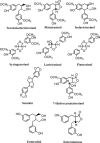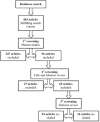Factors Explaining Interpersonal Variation in Plasma Enterolactone Concentrations in Humans
- PMID: 30817848
- PMCID: PMC7317467
- DOI: 10.1002/mnfr.201801159
Factors Explaining Interpersonal Variation in Plasma Enterolactone Concentrations in Humans
Abstract
Lignans are diphenolic plant compounds with potential health modulating properties that are absorbed to the circulation and metabolized to the enterolignans enterodiol (END) and enterolactone (ENL) by gut microbiota. Epidemiological studies have inconsistently shown that a high lignan intake and circulating ENL are associated with reduced risk of breast-, prostate-, and colorectal cancer as well as cardiovascular disease and total and cause-specific mortality. Inconsistencies can be due to interpersonal variation of ENL formation or responses. The aim of this review is to identify and evaluate the impact of factors influencing variability in plasma concentrations of the main enterolignan, ENL. The main determinants of plasma ENL concentrations are intake of lignan and lignan-rich foods, composition and activity of intestinal microflora, antimicrobial use, nutrient intake, BMI, smoking, sex, and age. Composition and activity of the intestinal microbiota appear to be the most critical factor governing interpersonal variability in plasma ENL concentration followed by the use of antibiotics. Future studies with combined data from gut microbiota and metabolomics with food intake and life style data can be used to estimate the relative contribution of the different factors to ENL concentration in quantitative terms.
Keywords: determinants; enterolactone; interpersonal variation; lignans; plasma.
© 2019 WILEY-VCH Verlag GmbH & Co. KGaA, Weinheim.
Conflict of interest statement
The authors declare no conflict of interest.
Figures



Similar articles
-
Relation between plasma enterodiol and enterolactone and dietary intake of lignans in a Dutch endoscopy-based population.J Nutr. 2007 May;137(5):1266-71. doi: 10.1093/jn/137.5.1266. J Nutr. 2007. PMID: 17449591
-
Intake of whole grains and vegetables determines the plasma enterolactone concentration of Danish women.J Nutr. 2004 Oct;134(10):2691-7. doi: 10.1093/jn/134.10.2691. J Nutr. 2004. PMID: 15465768
-
Effect of Antibiotics and Diet on Enterolactone Concentration and Metabolome Studied by Targeted and Nontargeted LC-MS Metabolomics.J Proteome Res. 2017 Jun 2;16(6):2135-2150. doi: 10.1021/acs.jproteome.6b00942. Epub 2017 May 3. J Proteome Res. 2017. PMID: 28294620
-
Role of dietary lignans in the reduction of breast cancer risk.Mol Nutr Food Res. 2007 Jul;51(7):857-66. doi: 10.1002/mnfr.200600240. Mol Nutr Food Res. 2007. PMID: 17576639 Review.
-
Lignans and human health.Crit Rev Clin Lab Sci. 2007;44(5-6):483-525. doi: 10.1080/10408360701612942. Crit Rev Clin Lab Sci. 2007. PMID: 17943494 Review.
Cited by
-
Dietary lignans, plasma enterolactone levels, and metabolic risk in men: exploring the role of the gut microbiome.BMC Microbiol. 2022 Mar 29;22(1):82. doi: 10.1186/s12866-022-02495-0. BMC Microbiol. 2022. PMID: 35350985 Free PMC article.
-
Accounting Gut Microbiota as the Mediator of Beneficial Effects of Dietary (Poly)phenols on Skeletal Muscle in Aging.Nutrients. 2023 May 18;15(10):2367. doi: 10.3390/nu15102367. Nutrients. 2023. PMID: 37242251 Free PMC article. Review.
-
Regional Diets Targeting Gut Microbial Dynamics to Support Prolonged Healthspan.Front Microbiol. 2021 Apr 29;12:659465. doi: 10.3389/fmicb.2021.659465. eCollection 2021. Front Microbiol. 2021. PMID: 33995322 Free PMC article. Review.
-
Targeting the delivery of dietary plant bioactives to those who would benefit most: from science to practical applications.Eur J Nutr. 2019 Nov;58(Suppl 2):65-73. doi: 10.1007/s00394-019-02075-5. Epub 2019 Oct 22. Eur J Nutr. 2019. PMID: 31637468 Free PMC article. Review.
-
Phytonutrients and outcomes following breast cancer: a systematic review and meta-analysis of observational studies.JNCI Cancer Spectr. 2024 Jan 4;8(1):pkad104. doi: 10.1093/jncics/pkad104. JNCI Cancer Spectr. 2024. PMID: 38070485 Free PMC article.
References
-
- Morisset A. S., Lemieux S., Veilleux A., Bergeron J., Weisnagel J. S., Tchernof A., Br. J. Nutr. 2009, 102, 195. - PubMed
-
- Borriello S. P., Setchell K. D., Axelson M., Lawson A. M., J. Appl. Bacteriol. 1985, 58, 37. - PubMed
-
- Adlercreutz H., Crit. Rev. Clin. Lab. Sci. 2007, 44, 483. - PubMed
-
- Hollænder P. L., Ross A. B., Kristensen M., Am. J. Clin. Nutr. 2015, 102, 556. - PubMed
-
- Aarestrup J., Kyrø C., Knudsen K. E. B., Weiderpass E., Christensen J., Kristensen M., Würtz A. M. L., Johnsen N. F., Overvad K., Tjønneland A., Olsen A., Br. J. Nutr. 2013, 109, 2269. - PubMed
Publication types
MeSH terms
Substances
LinkOut - more resources
Full Text Sources

